Sony HX300 Review
Pros: Super-versatile 50x optical zoom lens helps you capture everything from wide-angle cityscapes to zoomed in portraits from what feels like a mile away; Still quite light and portable considering the powerful lens; Comfortable and ergonomic design; Full HD video recording at up to 60p, with good quality.
Cons: Relatively small, 1/2.3-inch CMOS sensor delivers average image quality that degrades quickly at high sensitivities; Images not as sharp or as bright at full telephoto as we had hoped; Slow camera to use overall.
Price and availability: The Sony Cyber-shot DSC-HX300 started shipping in March 2013. With a list price of US$500, the HX300 currently retails for around US$430. It is available in only one color: black.
If you're not worried about extending yourself too far -- or bringing the action too close -- the Sony DSC-HX300 could be the all-in-one, superzoom camera for you. Featuring a 50x optical zoom, the Sony HX300 supplants the HX200V (and what now seems like its relatively paltry 30x optical zoom) in the manufacturer's bridge camera lineup.
The HX300's Carl Zeiss Vario-Sonnar T* lens boasts an equivalent focal range of 24-1,200mm (with a maximum aperture of f/2.8 to f/6.3 across the zoom range), combined with a new Sony 20.4-megapixel, 1/2.3-inch Exmor R CMOS sensor designed to deliver high resolution images, even from afar.
The zoom range of the HX300 gets outright ridiculous when you factor in its 2x "Clear Image" digital zoom, which combines with the lens for an up-to 100x reach. Add in the standard digital zoom, and you'll get all the way to 200x combined zoom, albeit with a significant degradation in image quality.
Like the HX200V, the new Sony HX300 features a DSLR-like look and feel, without the hassle -- and weight -- of interchangeable lenses. But, as expected, there are some serious image quality compromises with choosing a bridge camera over a DSLR. However, Sony has tried to "bridge" that gap as much as it can with the HX300.
The company claims the Sony HX300 features a first among its Cyber-shot cameras: a new generation of Sony's Optical SteadyShot system that delivers nearly twice as powerful optical image stabilization as its predecessor. The improved OIS is especially helpful at the telephoto end of the range, making distant framing and composition much easier, and it's achieved courtesy of a second zoom group of lens elements. Sony has also improved low-light performance, and says the HX300's sensor and processor work together to double the autofocus speed over the HX200V in an attempt to equip photographers with a more responsive, more powerful superzoom camera experience.
The Sony HX300 also features a newly designed ergonomic grip, and a diverse collection of controls, including a manual ring, custom button, jog dial and Memory Recall mode. There's a tilting, 3-inch, 921K-dot LCD monitor and a Multi-Terminal to communicate between the HX300 and compatible accessories. And a better Lithium-ion battery now extends life to 310 shots on a single charge.
Other performance enhancements include high sensitivity shooting at up to ISO 12,800 with the help of Sony's "By Pixel Super Resolution" upsample algorithm and multi-shot overlay. For standard images, the HX300's sensitivity tops out at ISO 3200. The camera is also capable 10 frames-per-second full-resolution burst shooting, as well as Full HD (1080p) video recording. The Sony HX300 comes with a new generation of Superior Auto Mode that automatically selects the proper settings to make composition and exposure easier, as well as Picture Effects ranging from Toy Camera to Partial Color. And, like many Cyber-shots, the HX300 lets you take 360-degree panorama shots.
Those are some pretty nice-sounding upgrades in a relatively compact, all-in-one superzoom camera designed for those who don't want the muss and fuss of interchangeable lenses. Let's take a closer look at the Sony HX300, and see if it's not only a worthy successor to it's superzoom predecessor, but worth investing in for all your picture-taking needs.
Look and feel. The Sony HX300 doesn't look markedly different than its predecessor, and that's a good thing. Sony has done a nice job of matching the curving, ergonomic design of its higher-end, SLR-style Translucent Mirror interchangeable lens cameras to its all-in-one superzoom models, and the HX300 is the latest evolution of this style. Hard core DSLR users might find the multi-tasking Sony HX300 a bit quaint -- or even dated -- but casual travel photographers who want to lighten the load will appreciate its sculpted, do-everything, joie de vivre.
The Sony HX300 has dimensions of 5.1 x 3.7 x 4.1 inches (130 x 93 x 103mm) and weighs 22.9 ounces (650g) with its rechargeable battery installed. It's slightly bigger and heavier than the previous model in this line, but still smaller and lighter than most DSLRs. (Though it's worth noting that Canon's super-tiny SL1 SLR is slightly more petite and less than an ounce lighter than the HX300, but of course that's without a lens.)
The design and size of the Sony HX300 (right) is very similar to that of other Sony entry-level cameras like the Sony A58 (left) and Sony A3000 (middle).
|
The Sony HX300 looks very similar to the company's entry-level DSLRs. In particular, it closely resembles the Sony A58, which replaced both the A37 and A57 as an introductory DSLR for beginners. The HX300 is also in the A58's price range, retailing for $100 less than that interchangeable-lens-based camera. So why wouldn't entry-level photographers just go with the DSLR? The main reason, of course, is that with the HX300, you get the whopping 50x zoom built-in lens. The A58, on the other hand, comes with a standard 18-55mm, 3x zoom kit lens. (Optical quality, however, is not quite equal, which I'll discuss later.)
When the Sony HX300 is powered down, the 50x zoom's barrel protrudes from the camera body about two inches. Power it on though, via the On/Off button on top, and the built-in zoom extends to about three inches, giving you the 24mm equivalent wide lens setting. Zoom it all the way out to 50x (1,200mm equivalent), and the lens telescopes to about 4.5 inches. These are all slightly longer than its predecessor, but the HX300 does have two-thirds more zoom reach. Also, compared to what a 1,200mm lens for a large-sensor camera looks like (these über-telephotos are rare to see in the wild, but they are impressive), the Sony HX300 is practically a munchkin, even when at full zoom.
On its front, you'll see the Sony HX300's rubberized grip, which has a textured feel resembling leather. This molded, ergonomic grip is similar to the one on the previous model, with an indentation for your middle finger. On the whole, it's quite comfortable, even for someone with big hands such as yours truly. Overall, the fit and feel is very much like that of a DSLR.
Looking down from the top of the camera, you'll see the Sony HX300's stereo microphone behind the pop-up flash. One of the biggest design differences between the HX300 and Sony's DSLR is the small left shoulder of the camera, which has no buttons, dials, or switches. There's just the model name, and some markings to indicate that the camera records HD video with AVCHD Progressive compression. Unlike the previous model, which had a built-in GPS receiver with which to geotag images, Sony has dropped that feature from HX300 and, consequently, the satellite logo has been stricken from the left shoulder of the camera
The larger right shoulder of the Sony HX300 is where all action is, with the camera's main controls, including the Mode dial, residing there. The polycarbonate top piece is flatter than on the previous camera -- which featured a raised area for the controls -- making it easier to slide your finger down to the shutter button. The oval shaped On/Off button has been moved towards the middle of the camera where the housing starts to curve up toward the electronic viewfinder and the pop-up flash. This is, presumably, to prevent your accidentally hitting the On/Off button with your finger while shooting. Under the On/Off button is a button that lets you switch between using the viewfinder and the LCD for viewing images in playback and menus, and in Record mode.
In front of the Mode dial on top of the handgrip are a pair of buttons. One selects the Focus mode (Multi AF, Center AF, or Flexible Spot AF) if you simultaneously turn the jog dial on back of the camera; the other is a programmable Custom button which defaults to exposure lock. On top of the front of the handgrip is a black, matte Shutter button surrounded by the zoom ring, both of which are more raised -- but slightly smaller -- than in the previous camera.
LCD monitor. The rear of the Sony HX300 is dominated by the 3-inch, fold-out LCD screen, which stands proud a quarter-inch when retracted against the camera body. It's a nice screen for framing and reviewing shots, offering 921,600 dots of resolution (307,200 pixels), but it hasn't been upgraded from the previous camera. The LCD is not a full, side-swiveling flip-out screen, which would have been a nice addition. Instead, as with the previous camera, you can pull the screen out and tilt it up or down, which helps when composing over the head or down low shots. As before, the HX300's LCD is not touch-sensitive.
The Sony HX300 doesn't have an optical viewfinder but, if you're more comfortable with putting your face to the camera when composing shots, does feature a small, 0.2-inch electronic viewfinder with 201,600 dots of resolution. While it's not as sharp or as detailed as the LCD screen, the EVF is a good alternative when you don't want to frame your shots at arm's length, or are shooting in bright light and can't see the rear screen. Again, the EVF is pretty much the same as the one on the HX300's predecessor. However, unlike that the previous model, the HX300 doesn't include a proximity sensor to automatically turn on the EVF when you put your eye there. (This feature didn't work very well in the HX300's predecessor anyway, but it was still nice to have it as an option.)
Above the rear LCD screen is the one-touch Record button for video capture. The Playback button has, wisely, been moved further below the Movie button, so you don't accidentally press it when you want to start shooting movies. To the right, under the Mode dial, is the Jog wheel. You can also press this in, so that it functions as a button as well, which I find a bit odd. Below that is the Four-way Control pad, which lets you adjust the display, flash, timer, burst shooting and other features.
At the very bottom of the back of the camera are the Menu and Delete buttons. The latter doubles as the In-Camera Guide button when the Sony HX300 is in shooting mode.
50x optical zoom lens. The most newsworthy thing about the Sony HX300 is, of course, its 50x optical zoom lens. The lens carries Carl Zeiss Vario-Sonnar T* branding, and the camera sports a "50X Optical Zoom" sticker on the pop-up flash above the lens barrel to advertise its skills. If you're impressed by numbers, this mighty optic has them in spades. Its 35mm equivalent range ranges from a very handy 24mm wide-angle to an astronomical 1,200mm telephoto. Maximum aperture, however, falls from f/2.8 at wide angle to a rather dim f/6.3 at telephoto, so avoiding blur from camera shake at the maximum telephoto in tough lighting will prove tricky, even with Sony's Optical SteadyShot image stabilization.
Sony says the HX300 has "new and improved" autofocus speeds at the telephoto settings, and locks in on subjects "twice as fast" as the previous camera, the HX200V. The HX300's predecessor was not particularly swift, so this is good to hear. We'll address whether the HX300 lives up to that autofocus speed billing in the shooter's report below.
Sensor. The Sony HX300 offers a slight uptick in resolution from the previous camera, sporting a 20.4-megapixel (effective), 1/2.3-inch Exmor R CMOS sensor. While the HX300's resolution is on par with what you'd get from many entry-level DSLRs, there's no getting around how small the chip is. With a diagonal of just 7.76 millimeters, it's the same size used in many point-and-shoot cameras. The HX300's imager is, however, a BSI chip with more of its surface area devoted to light gathering. (The chip's circuitry has been moved below the active layer of the sensor, so it doesn't block the incoming light.)
Even with the smaller chip, the Sony HX300's ISO range is similar to that of a DSLR: ISO 80 to 12,800. When shooting above ISO 3200, though, the HX300 enters its "extended ISO" setting, where several images are automatically shot in succession at a low resolution and then combined while being interpolated.
Storage, battery and interface. Images and movies are stored in 48MB of built-in memory, or on SD / Memory Stick Duo cards. Supported SD cards include SDHC and SDXC types, while Memory Stick Duo compatibility includes PRO Duo and PRO HG Duo types, as well as Micro and Micro Mark 2 cards with an adapter.
Power comes courtesy of a proprietary NP-FH50 InfoLithium rechargeable battery pack, rated as good for 310 shots per charge using the LCD monitor, and 400 shots per charge using the EVF.
Connectivity to external devices is fairly limited with the HX300, as it lacks more advanced features like Wi-Fi or NFC wireless communications. It does have a Micro HDMI port and a multi-function mini-USB port for both AV output and computer connectivity via USB 2.0.
Shooting with the Sony HX300
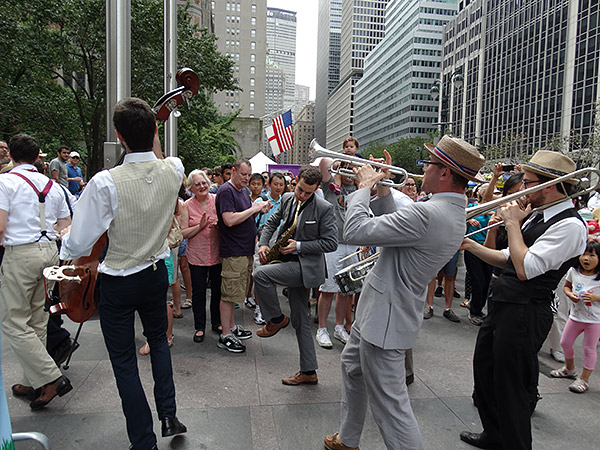
As someone who gets to test a lot of high-end gear, including many professional digital SLRs and lenses, I tend to be snobbish towards cameras like the 20.4-megapixel, 50x optical zoom Sony HX300. But a lot of us forget that despite the popularity of interchangeable-lens camera systems -- including all the mirrorless compact system cameras continuing to flood the market -- all-in-one, superzoom "bridge" cameras are still a highly attractive option for novice photographers. And why shouldn't they be? With versatile, incredibly long zooms and a bevy of features, fully-loaded superzooms like the HX300 are handy image-making tools for travelers and tourists alike.
I found that out last year, when I took the HX300's predecessor, the 18.2-megapixel, 30x optical zoom HX200V on a trip to Berlin, Germany. While I didn't like everything about the HX200V -- its image quality wasn't always up to snuff in challenging situations -- it allowed me to travel with one camera and no additional lenses, yet still get plenty of great shots in a variety of locations and scenes in Berlin.
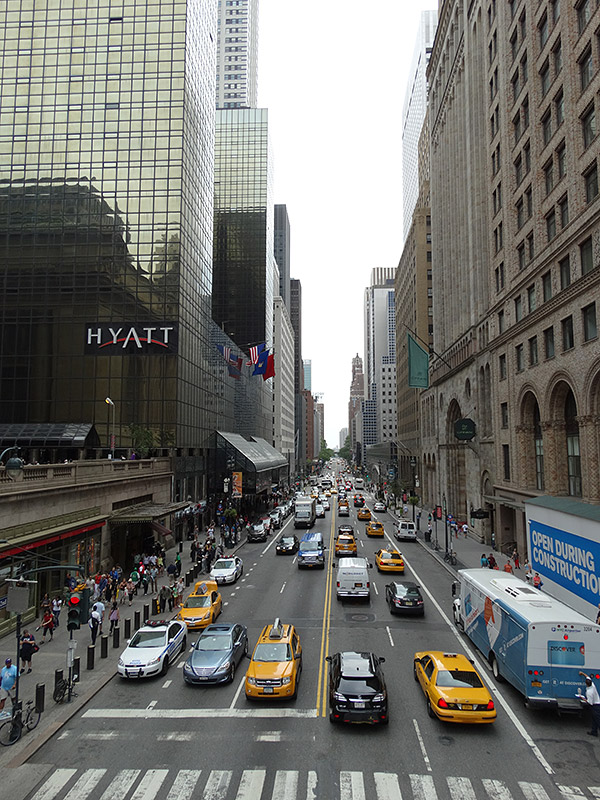
Aside from the jump from a 30x to a 50x zoom (which is a significant boost), the Sony HX300 offers only a few other upgrades from the previous model. In a few areas, it actually takes away a few features that were on the older camera. That HX300's larger zoom also makes the camera slightly larger and heavier, and bumps the price up just a bit, with this new model retailing for $500 list. Is a bigger bridge camera with a more powerful zoom, worth your time, money, and consideration? Let's take a look at this new superzoom champ from Sony.
In the hand. As we already stated in the earlier walkaround section, the Sony HX300 looks and feels a lot like Sony's entry-level DSLRs. At the same time, however, it's a little less serious than those models -- which makes sense, given its more consumer-focused audience. Maybe it's the HX300's almost completely curved design, which, aside from the rectangle inset of the 3-inch, fold-out LCD screen, has no right angles. Or maybe it's the slight, lower-slung electronic viewfinder on top of the camera, which gives the HX300 a more modern appearance. Either way, this Sony flagship superzoom may seem advanced with all its features, but it looks and feels accessible and unintimidating. This should appeal to novice users.
The Sony HX300's textured, rubber handgrip is robust, boasting an ergonomic design with indentations for your middle and third fingers. My hand fit comfortably around it. As opposed to some mirrorless, compact system cameras I've tried, which always seem ready to fly out of your hand, the Sony HX300 felt more like an extension of my hand. It is, however, fairly heavy, weighing about 23 ounces,. That's heftier than the previous model, and comparable in weight to some entry-level DSLR bodies, if you ignore their lack of a lens. Even when it's retracted, the HX300's 50x lens juts out a few inches from the camera body, presenting a bigger package than many CSCs. And, of course, when you zoom the HX300's lens out to its full 1,200mm-equivalent setting, this superzoom becomes a bit of a beast.
I wasn't able to stash the Sony HX300 into a coat pocket -- it was too big and bulky -- but it fit easily into a small camera bag and seemed ideal for travelling. (And considering how much is packed into this superzoom, it beats carrying around a camera body and a collection of lenses, all image quality concerns aside.)
One slight annoyance that struck me about using the HX300 out in the field -- and I had a similar issue with the HX200 before it -- is that the camera has a bit of a rattle when you move it around, making it feel less solid than a DSLR.
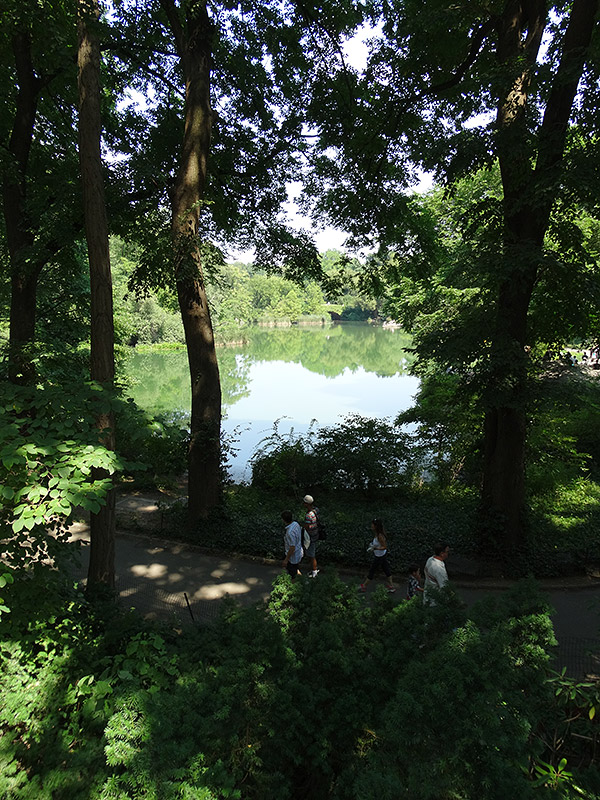
Controls. Since the Sony HX300 is aimed, primarily, at less experienced photographers, controls are pretty basic, and for the most part logical. We've detailed where everything is on this camera in the walkaround section above; now let's address the usability of the camera's knobs, switches, dials and whirligigs.
In short, everything works as it's supposed to, albeit with a few quirks. I liked the slightly more raised Shutter button with the surrounding Zoom ring of the Sony HX300, but it still felt mushy. It's similar to the difference between the vague steering you find on most cars these days, and the tighter, more tuned control on sportier models. While the black matte shutter is more attractive than the glossy, shiny metal on the previous camera, it still seemed on the cheap side, as did the plastic zoom ring around it. Otherwise, the polycarbonate top deck of the HX300 and the four slightly recessed buttons looked spiffy, and stayed out of my way when I didn't need them. The raised, knurled Mode dial was also pretty snazzy, and had a nice Goldilocks quality to it: not too tight to turn and not too loose, preventing accidental changes.
The button layout on the rear of the Sony HX300V (right) underwent only minor changes compared to the previous model, the HX200V (left). The Movie record button has been moved slightly farther away from the thumb-rest area.
|
On the back of the Sony HX300, the red Movie button was in an easy-to-see, easy-to-access location next to the electronic viewfinder and near the top of the camera. It's far enough out of the way of the thumb rest so that I didn't hit it by mistake. (That had happened to me a few times with the previous model, to my chagrin.)
What's most confounding about the controls of the Sony HX300, as was the case with its predecessor, is the multi-functionality of the plastic Jog wheel on back of the camera. If you didn't read the Sony HX300's manual, you might not know that the wheel, which sits on top of the rear thumb rest below the mode dial, doubles as a button. You can use it to change basic settings such as ISO sensitivity, shutter speed and aperture. To change sensitivity, for instance, you have to keep pressing the jog dial in until the sought-after setting lights up in yellow on the rear LCD, which allows you to adjust the ISO by turning the dial. The same system is used for aperture, shutter speed and exposure compensation. This setup may be common on Sony's superzoom cameras, but I doubt most folks will be able to figure it out on their own.
Otherwise, the rest of the Sony HX300's rear controls were pretty straightforward, if small and sparse. Would it have killed Sony to have put a dedicated ISO button on the back of the camera, though, rather than making photographers tap that infernal jog dial?
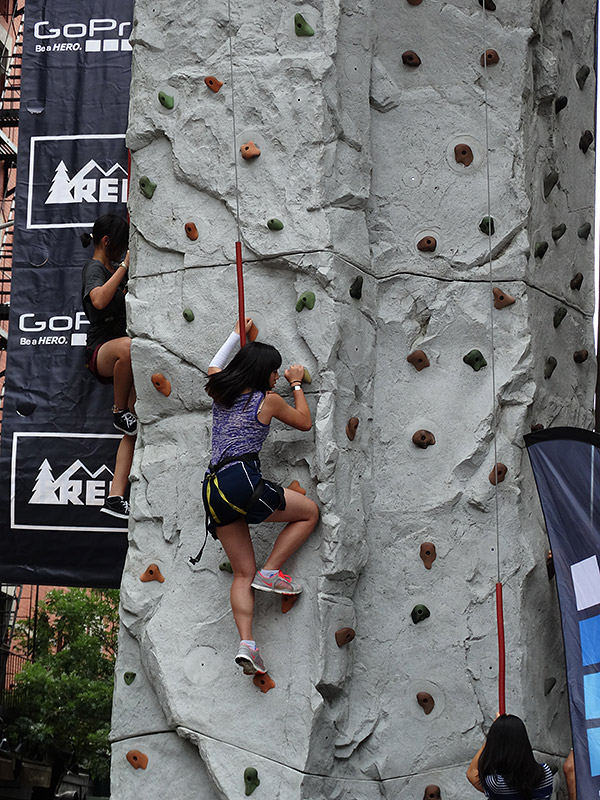
LCD screen and EVF in use. The 3-inch, fold-out LCD screen on back of the Sony HX300 is the same as that of the previous model, and while it's a very good display, it would've been nice if it had been upgraded. As it is, the screen had ample resolution (921,000 dots) for previewing and reviewing my shots. As with many LCDs, it can be hard to see in outdoor light. I shot with the HX300 extensively in bright, summer light while using the camera during Summer Streets in New York City. For those not familiar with the event, during Summer Streets on Saturdays in August, nearly seven miles of NYC's streets are shut down to car traffic, and pedestrians are free to walk, run, or bike on the roads. It's a fun event, and the HX300 proved to be a handy companion.
Big crowds lined the Summer Streets route and dancers, musicians and performers held demonstrations to entertain the crowd along the way. Though I'm a tall guy, it was nice having the fold-out LCD screen, which allowed me to hold the Sony HX300 over my head, and compose shots over the crowds of people. In particular it helped me get some good photos and video of a jump rope crew performing. A side-swiveling screen would have been even better for composing shots from difficult angles -- and for selfies! -- and it would have been a nice upgrade to set the HX300 above its predecessor. (However, it might also have added significantly to the price, which could explain why it wasn't added.)
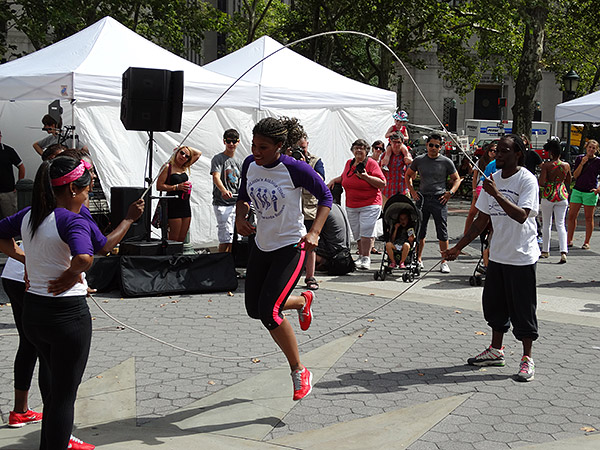
The Sony HX300's electronic viewfinder, which is based around a 0.2-inch LCD panel, also hasn't been upgraded from the older camera. That's even more of a shame, as I found it very cramped -- I had to squint to see through it -- and the 201,600 dots of resolution weren't enough to create a sharp, live preview. While shooting in the bright light of Summer Streets, it helped me compose shots in pinch when the rear LCD completely washed out, as it often did. But it wasn't ideal.
Also, as mentioned earlier, the Sony HX300's viewfinder does not have an eye detection function. Instead you have to hit a button on top of the camera to turn the EVF on. While the auto EVF feature on the previous camera was pretty lousy -- I remember it being glacially slow to engage, which caused me to miss some shots -- it would have been nice at least to have it as an option on the HX300, especially if Sony could have made it work quicker.
Superzoom lens and autofocus. The Sony HX300's key feature is, of course, its impressive 50x, 24-1,200mm equivalent (in 35mm format) superzoom lens. And it proved valuable for capturing photos I could not have possibly shot otherwise. (Unless, of course, I had a 1,200mm telephoto for my large-sensor camera, which I do not.) As part of the Summer Streets celebration, organizers had set up an urban zip line in Foley Square in front of the 1933-built U.S. Courthouse. With the HX300's wide zoom range, I was able to photograph a wide-angle scene setter showing the zip line apparatus in front of the classic courthouse, and then a zoomed-in shot to capture the excited faces of people riding the zip line. This also worked great when zooming for some action video footage of the zip line.
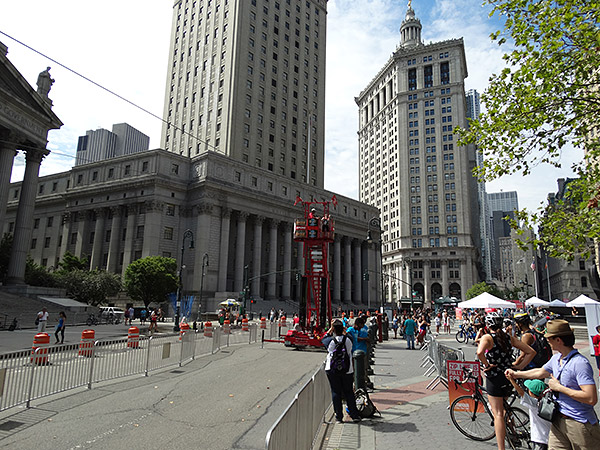 |
Wide-angle @ 24mm
|
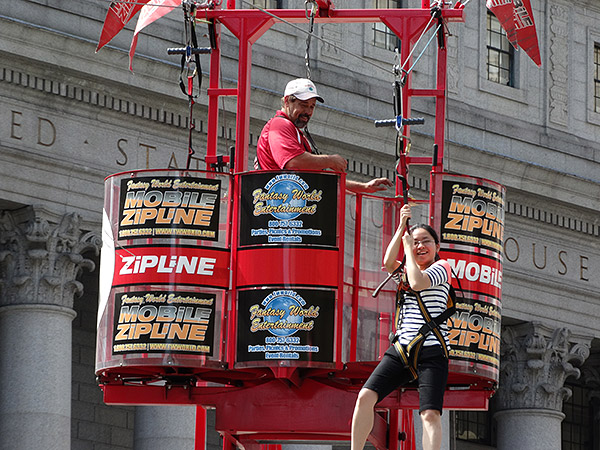 |
Mid-tele @ ~240mm
|
Other great photo opportunities the Sony HX300's megazoom generated for me included a shot I captured of a group of pigeons standing on top of an extremely dirty traffic light in New York City. Not only was I able to isolate the birds and the light for a close-up composition, the compression the long zoom created isolated the foreground and flattened the background to add drama to the photo. My traffic light image, which I dubbed "New York Grime," ended up being voted one of the most popular of the day on photo-sharing site, 500px.
The Sony's HX300's long zoom also came in handy when I played local paparazzi right from my office window. Actor Ron Perlman grew up in the New York City neighborhood where my home office is, and I've seen him from time to time shopping at the local bakery and supermarket. (If you don't know Perlman, he plays Clay Morrow in the TV series "Sons of Anarchy," and has starred in many movies, including Blade II, and as the title comic book character in Hellboy and Hellboy II: The Golden Army.)
One day, while looking out my office window, I spied Perlman sitting on a sidewalk stoop with his dog. Thanks to the HX300's zoom and tilting LCD screen, I was able to hold the camera over my head while sitting at my desk, zoom in to get Perlman in the frame, and snap a few photos. Very cool and completely inconspicuous.
While the Sony HX300's generous 24-1,200mm optical zoom range is handy for a range of shooting situations, you do sacrifice on the aperture when you zoom in. At the widest angle, you can shoot at f/2.8, which comes in handy in mixed lighting situations. And since the HX300, like its predecessor, is a mediocre performer at higher sensitivities -- more about that below -- you'll find yourself trying to shoot at that f/2.8 aperture as much as possible. On the other hand, maximum aperture when you zoom all the way out to 50x is just f/6.3, making the Sony HX300 a poor performer in low light at the full telephoto position.
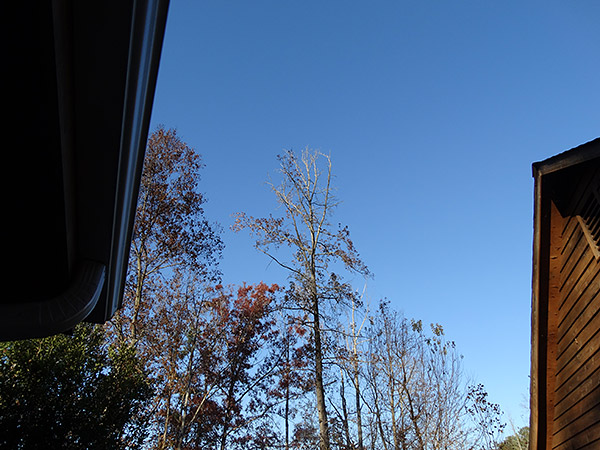 |
Wide-angle @ 24mm
|
 |
200x zoom - 50x optical zoom with Clear Image Zoom and Digital Zoom enabled.
|
The Sony HX300's autofocus speeds were a bit better than its predecessor, which was on the slow side. Sony says the HX300's sensor and processor work together to provide the extra bump in focusing speed. In our testing, the HX300 averaged about 0.38 of a second to lock in focus when shooting at the wide angle, and 0.13 second at telephoto. That's about average at wide angle, but very fast at telephoto for a superzoom camera. If you've shot with a DSLR before, though, you'll find the HX300 to be a step slow.
The HX300 features a new version of Sony's Optical SteadyShot system, which the company says is twice as powerful as that of its predecessor. The new OIS now performs better at the telephoto end, and I found it largely did a good job. When zoomed all the way out to 50x (which, you have to keep reminding yourself translates to 1,200mm!), the OIS kept the image relatively steady, though the Live View does tend to swim around on the rear LCD screen. That's not surprising considering how tightly it's framed, but if you find this distracts your framing of images, I'd suggest using the EVF for 50x shots. Thanks to Optical SteadyShot, my images had very little motion blur, and that's impressive considering how much reach the HX300's superzoom lens offers. While Optical SteadyShot is quite powerful, there's no way to turn it off on the HX300 if, for instance, you want to shoot with the camera mounted on a tripod.
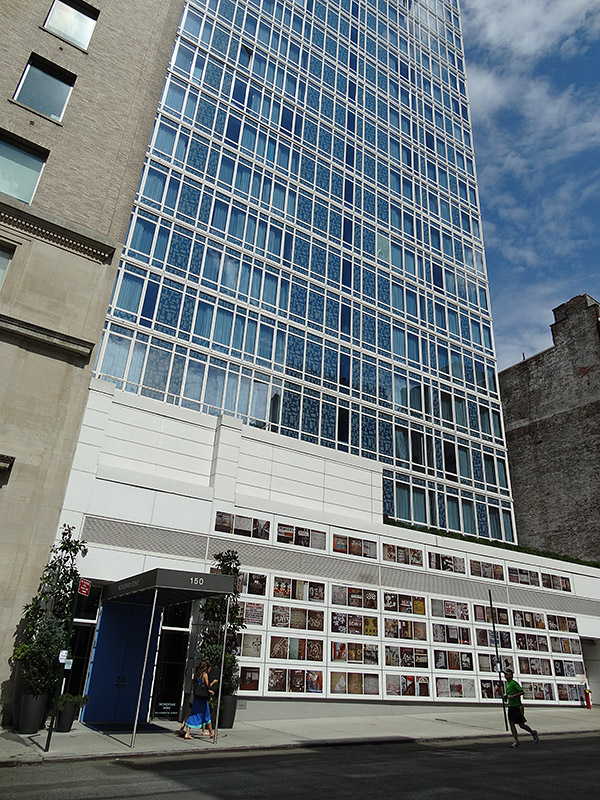
Operational performance. Along with the modest focusing speeds, the Sony HX300 is a slow camera to use all around. The HX300 averaged 2.4 seconds to power on and get to first shot, which is actually slower than its predecessor by about .2 of a second. Considering that the HX300's zoom lens is longer physically -- and by focal length -- that's not unexpected. But if you're in a hurry to fire off a shot quickly, this is not the camera for you.
Shot to shot, the Sony HX300 was about average for the class. I averaged cycle times of about 1 to 1.5 seconds, when shooting Large/Fine JPEG images using a SanDisk Ultra 8GB 30MB/s SD card. While that's not, in itself, terribly sluggish, the camera's rear display and/or EVF blacks out between shots, and it can feel like a lifetime not to see your subject if you're trying to capture a series of candid shots. (See further below for our lab performance results, which uses a faster 8GB 95MB/s SD card.)
The Sony HX300 does offer rapid-fire, 10 frames-per-second full-resolution burst shooting mode, but after you fire off a round of 10 shots, the camera takes a couple of seconds to store them before you can shoot again. This makes the burst function less useful for tracking and capturing fast action sports, which is a pity because the long zoom helps you isolate players from a distance. Anyone who has used a DSLR with a bigger buffer that lets you keep on shooting will find the Sony HX300 to be frustrating. And, if sports photography is your thing, you should probably invest in a DSLR.
The HX300 menus feel sluggish and involve lots of scrolling through options.
I've always found Sony's menu systems on its consumer cameras to be confusing and out-of-date, and it's the same case with the HX300. Checking settings is a slow process -- scrolling through options and modes was sluggish and buttons were not quick to respond -- and the set-up, mentioned earlier, of having the HX300's jog dial on back of the camera serve as a button, was also painfully slow to use.
Image quality. Like it's predecessor, the Sony HX300 captures nice images in good light at low ISOs but it fairs poorly in mixed or dim lighting at higher ISOs. With the previous model, we felt that 18.2-megapixels was too much resolution for a camera with such a small sensor, resulting in images that were quite noisy, even at base ISOs. The Sony HX300 uses the same sized, 1/2.3-inch-type CMOS image sensor as its predecessor -- equivalent in size to what's in small, point-and-shoot cameras -- but cranks the resolution up even further, meaning smaller individual pixels and image quality that is further degraded.
Don't get me wrong: I took a few photos with the Sony HX300, which were among my favorites of the year, such the traffic light image and some of the shots from Summer Streets. But these choice shots were thanks to the camera's wide zoom range offering me so many compositional options. When I zoomed in on some of my HX300 images, particularly those at ISO 800 and above, detail looked smeared. This was especially true in my zoomed-in shots, which had a noticeable softness all around, coming from a combination of a lens that was not particularly sharp at full tele, and the small image sensor that didn't capture images with much crispness. Skin tones also looked oversaturated, pink-ish, and not very natural looking.
ISO 100
|
ISO 1600
|
Though the Sony HX300 can shoot above ISO 3200, it does so by firing off several images at once, which are then combined into one. The noise has been tamped down somewhat in the HX300's extended ISO settings, but images captured at ISO 6400 and especially at ISO 12,800 had detail that was extremely smeared and blotchy, making photos at this level look like surreal paintings.
Of course, I'm being a bit hard on the Sony HX300's image quality. Like I said, it offers many tools for capturing great photos -- the megazoom alone is worth the camera's pricetag -- so there will be, of course, some trade-offs. At lower ISOs in good lighting, the Sony HX300's images were fine and color looked accurate and snappy. This isn't the camera, however, that I'd turn to for any challenging shooting conditions. In addition to its poor low-light performance, dynamic range was only so-so. As evidence, look at the shots of the jump-rope team in my Sony HX300 gallery, where there is very little discernable detail in the performers' black leggings.
Video Quality. The Sony HX300 is a fine, all-in-one video camera, with its wide zoom range making it quite versatile for a number of shooting situations. Like the previous model, the HX300 captures Full HD (1080p) video at 60p or 60i with stereo sound, using AVCHD compression. If you want to shoot movies in MPEG4 (MP4), which I find more flexible, you can choose that format, but recording is only available at 30p.
Gallery Sample Video with Zooming1,920 x 1,080, AVCHD, Progressive, 60 fps
Download Original (102MB .MTS) |
The Sony HX300's video quality ran parallel to its still image quality, good in decent light but somewhat noisy under tougher conditions. (Though, I have to admit, I'm more forgiving with noise in video footage than for still photos.) For most photographers who are just starting to explore shooting in HD, the HX300 is a good introductory video camera, with its long zoom lens a great tool for getting a range of footage. While shooting video of a band playing ragtime music as it walked through a crowd during Summers Streets, I was easily able to track the action in wide-angle, and then silently zoom in on members of the crowd as the musicians passed them.
Also, there was very little of the wobbly "rolling shutter" we see from some cameras with the Sony HX300, when I panned quickly while capturing footage of someone riding down the zip line. I primarily shot in MPEG-4 at 30p, which presents some challenges for very fast action. For instance, while shooting video of the jump rope crew doing some twin-rope "double dutch" maneuvers, the footage I captured of the fast-moving ropes looked laggy, with some artifacting. On the other hand, the Sony HX300's Active SteadyShot movie stabilizer did a good job of keeping my HD footage steady, even when zoomed in with the telephoto.
Summary. As far as superzoom "bridge" cameras go, you can't get much more zoom reach than you do from the Sony HX300. While the HX300's image quality sometimes disappointed me, especially when shooting at higher sensitivities, it's hard to argue with the versatility offered by a camera that boasts a 24-1,200mm equivalent zoom, weighs less than 23 ounces, and has a list price of just US$500 (with a somewhat cheaper street price of around US$429 as of November 2013.) If you're looking for a great, all-in-one megazoom to take on your next trip, you can't do much better than the Sony HX300.
Sony HX300 Lens Quality
Zoom Series: The Sony HX300's lens is fairly fast at the widest end, with a maximum aperture of f/2.8, but then falls to a maximum f/6.3 at full tele, covering a 50x optical zoom range equivalent to a 24-1,200mm zoom on a 35mm camera. Images at wider angle look a bit sharper than those at the telephoto end of the 50x optical zoom range. Sony implements two types of digital zoom: a standard digital zoom and their "Clear Image Zoom." The Clear Image Zoom provides 2x zoom, and uses pattern matching to retain the same pixel count. Regular digital zoom does much the same, but without the benefit of pattern matching, and so it's softer. By combining both digital zoom options with the 50x optical zoom, the HX300 is capable of an overall 200x zoom, and we were surprised at the detail captured with this extreme telephoto reach.
Here's how aperture varies with focal length, according to what the camera itself reports:
Focal Length (eq.)
|
24mm
|
50mm
|
85mm
|
135mm
|
200mm
|
300mm
|
400mm
|
600mm
|
1,200mm
|
Max. aperture
|
f/2.8
|
f/3.2
|
f/4.0
|
f/4.5
|
f/5.0
|
f/5.6
|
f/6.3
| ||
Min. aperture
|
f/8 at all focal lengths
| ||||||||
Wide-angle @ 24mm, f/2.8
|
50x optical zoom
|
200x zoom - 50x optical + Clear Image Zoom and Digital Zoom enabled.
|
Wide f/2.8: Sharp at center
|
Wide f/2.8: Soft, and showing some CA at upper left
|
Tele f/6.3: Slightly softer than wide angle in the center
|
Tele f/6.3: Much softer upper left, but less CA than wide-angle corners
|
Sharpness: The Sony HX300's zoom shows a fair amount of blurring in the corners of the frame compared to the center at maximum aperture. At the tele end, it becomes softer in the center than at the wide end.
Wide: Slight barrel (top) and pincushion (bottom) distortion
|
Mid-Tele (~477mm eq.): No distortion
|
Full-Tele (1,200mm eq.): Almost no distortion
|
Geometric Distortion: There is only a slight amount of asymmetrical distortion at the Sony HX300's wide-angle end (~0.4% barrel at the top, ~0.4% pincushion at the bottom), but once it's zoomed to mid-tele and on to full telephoto, distortion is practically non-existent.
Wide f/2.8:
Moderately low |
Mid-Tele f/5.6:
Moderately low |
Tele f/6.3:
Fairly low |
Chromatic Aberration: Chromatic aberration throughout the zoom range on the Sony HX300 is fairly well-controlled. While there is ever so slightly more in the corners at the wide end, there is practically none once it's zoomed to full tele.
Macro
|
Macro with Flash
|
Macro: The Sony HX300 doesn't have a dedicated macro mode, but it does focus down to as close as 0.4 inches (1cm) at the wide end. In fact, in Intelligent Auto mode, the camera will detect close focusing and call it "Macro" mode. The 0.4-inch minimum focusing distance allows for very close shots that are very detailed in the center, with a little distortion and some blurring in the corners. Minimum coverage area is 1.65 x 1.24 inches (42 x 32mm), which is much smaller than average. The camera's flash is almost entirely blocked by the large lens at this range, resulting in a strong shadow across the frame. Thus, external lighting will be your best bet when shooting this close.
Sony HX300 Performance
Startup Time: The Sony HX300 takes about 2.4 seconds to power on and take a shot. That's a little slower than average for its class.
Shutter Lag: Full autofocus shutter lag is about average for a long-zoom at 0.37 second at wide angle, and very fast at telephoto at 0.13 second. Prefocused shutter lag is 0.011 second, which is very quick.
Single-shot Cycle Times: Single-shot cycle time is good, capturing a large/fine JPEG every 0.93 second.
Flash Recycle: The Sony HX300's flash recycles in about seven seconds after a full-power discharge, which is pretty slow.
USB Transfer Speed: Connected to a computer or printer with USB 2.0, the Sony HX300's download speeds are good. We measured 12,452 KBytes/sec.
Battery Life: The Sony HX300's battery life has a CIPA rating of 310 shots per charge using the LCD monitor, and 400 shots per charge using the EVF, which is about average.
Sony HX300 Print Quality
Good 16 x 20 inch prints at ISO 80/100; makes a acceptable 8 x 10 inch print at ISO 800, and a usable 4 x 6 at ISO 3200/6400.
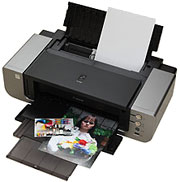 ISO 80/100 produces good 16 x 20 prints when viewed from a normal distance, with a nice amount of fine detail and pleasing colors. There are visible noise reduction artifacts however, especially in the shadows and on smoother, background areas. This seems odd for such a low ISO sensitivity, but the default level of noise reduction appears to be quite strong. Up close, a 20 x 30 inch print would be acceptable for wall display, but any print size larger appears a little on the soft side.
ISO 80/100 produces good 16 x 20 prints when viewed from a normal distance, with a nice amount of fine detail and pleasing colors. There are visible noise reduction artifacts however, especially in the shadows and on smoother, background areas. This seems odd for such a low ISO sensitivity, but the default level of noise reduction appears to be quite strong. Up close, a 20 x 30 inch print would be acceptable for wall display, but any print size larger appears a little on the soft side.
ISO 200 images look good up to 13 x 19 inches. The prints are ever-so-slightly noisier and less detailed than the lower sensitivity levels, but overall at this print size it's not very noticeable.
ISO 400 allows for prints up to 11 x 14 inches, although that's a difficult call, as the prints are right on the cusp of being a bit too soft and lacking in fine detail. However, the colors look good, and from a comfortable arms-length viewing distance, prints of this size still look pleasing.
ISO 800 images look good at 8 x 10 inches. It's here that the smaller 1/2.3-inch type sensor starts to struggle with fine detail and noise. The high ISO noise is noticeable in the shadows, and is really noticeable in larger print sizes.
ISO 1600 makes an acceptable 5 x 7 inch print, but fine detail is pretty sparse and noise is definitely an issue, preventing us from calling anything larger OK. The colors, however, looks decent for this sensitivity given the camera's smaller sensor.
ISO 3200/6400 prints definitely show image quality degradation from the high sensitivity and noise reduction taking its toll on fine detail, but a 4 x 6 inch print looks acceptable. For ISO 3200, a 5 x 7 might be acceptable for less critical applications, but it's a bit too soft for us to call it at that size.
ISO 12,800 does not yield good prints, and is best avoided.
The Sony HX300 is a pretty solid performer for a small-sensor, superzoom camera. It displays typical results for prints compared to other superzoom cameras, producing good 16 x 20-inch prints at low ISOs, and a usable 4 x 6 at ISO 3200 and 6400. At prints sizes of 8 x 10 or smaller, the HX300 does a nice job with good fine detail and pleasing colors (though we did see some strong noise reduction artifacts at the low ISO sensitivities in the shadows), but it's only when you reach ISO 800 and higher that the print quality starts to degrade.
Sony HX300 Review -- In the Box
The Sony Cyber-shot HX300 retail box contains:
- Sony HX300 camera
- NP-BX1 rechargeable battery pack
- AC-UB10 AC adapter
- Micro USB cable
- Shoulder strap
- Lens cap
- Instruction manual
Sony HX300 Review -- Recommended Accessories
- Extra NP-BX1 battery pack for extended outings
- Large capacity SDHC/SDXC memory card. These days, 16GB is a good trade-off between cost and capacity. Sony recommends Class 4 or higher.
- Small-to-medium camera case
Sony HX300 Review -- Conclusion
| Pro: | Con: |
|---|---|
|
|
As we felt with its predecessor, the Sony HX200V, we think the Sony HX300's strengths far outweigh its limitations, making this all-in-one superzoom a solid option for anyone who wants a camera to do a little bit of everything. The HX300's 50x optical zoom lens is a huge upgrade and an incredible tool, offering 24-1,200mm equivalent coverage. It's extremely versatile, allowing users to photograph a wide range of subjects, from close-ups of people riding a faraway zip-line to wide-angle shots of cityscapes. The HX300 handled these photo tasks smoothly and efficiently. Unless you're willing to pay tens of thousands of dollars for DSLR lenses, there are few alternatives that can do what the Sony HX300 can do, especially for such a relatively low pricetag.
About those limitations: Though the added resolution from the HX300's 20.3-megapixel CMOS sensor gives you a lot of digital image info to work with, the chip itself is the same size that you'd find in many point-and-shoot cameras. Time and again, when we looked closely at shots we captured with HX300's 1/2.3-inch sensor, details looked fuzzy and soft. This was particularly true of higher ISO images, which demonstrated considerable noise. Feature-wise, Sony has also removed a few functions with this camera that were available on the previous model, such as built-in GPS and the electronic viewfinder's eye-detect function. And we were a bit disappointed that the 3-inch, fold-out LCD screen and small EVF weren't upgraded from the previous model.
Having said all that, we still found the Sony HX300 a ton of fun to use; it even helped our reviewer capture some of his favorite images of the year -- some he couldn't have captured with many other cameras. The bottom line is that you just can't beat the versatility of a 50x zoom lens in a camera that's small enough to take with you everywhere. While its about the size of a small DSLR -- and slightly bigger and heavier than the previous model -- the Sony HX300 felt very comfortable in the hand, and light enough that it never weighed us down. The HX300's HD video mode is also nice and handy, letting us shoot high-quality clips in good light with just the touch of a well-placed button on back of the camera.
While there are some definite trade-offs with a superzoom camera, the power of the HX300's incredible 50x reach plus a host of solid features earns it a nod from us as a solid Dave's Pick.
No comments:
Post a Comment